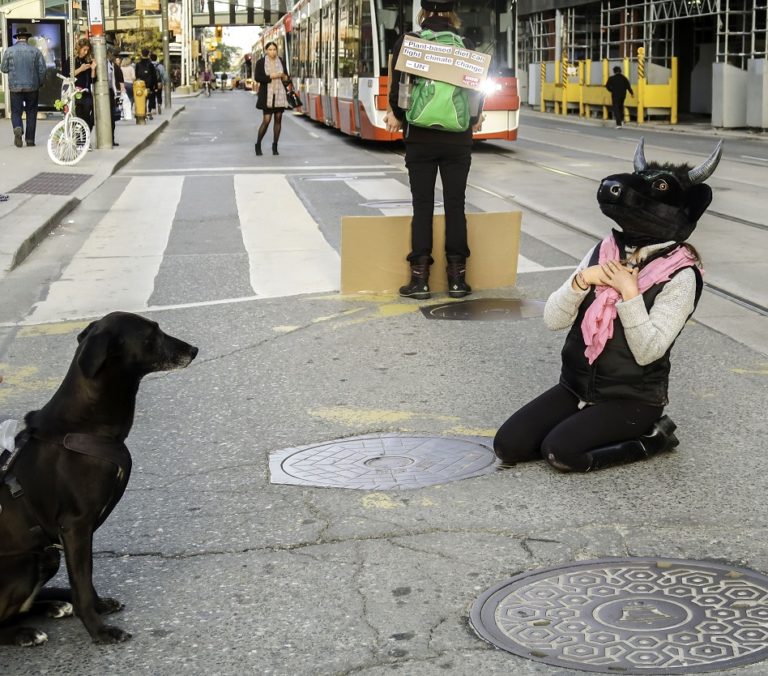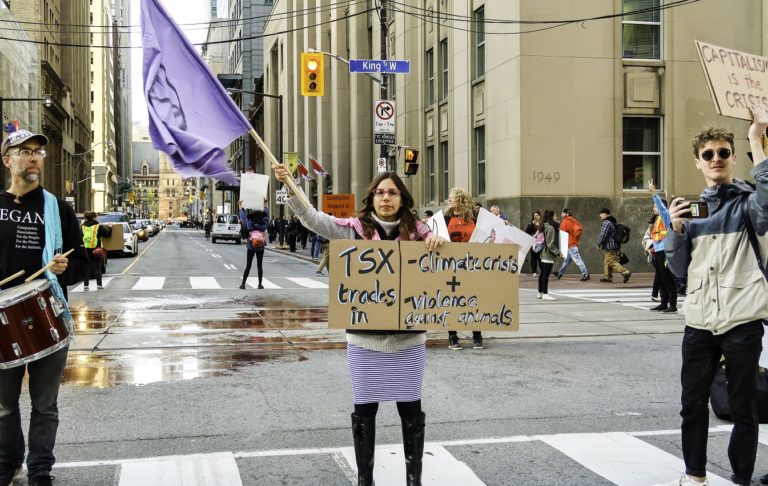To download a PDF version of this, please right click here.
Underlying Principles of Actions
We are a Mass Movement of Non-Violent Civil Disobedience
Animal Rebellion’s actions can be broken down into three types of action. Most of our protests will achieve all 3 at some level, but are often organised to focus on one over another.
Disruption, to create disruption through mass civil disobedience, towards achieving our demands.
Outreach, to tell the public the truth, and bring people together, at the protest, or through media.
Visioning, demonstrating the future we want to see through beautiful creative actions.
Through our actions we will try to outreach to new groups, create mass economic disruption, and vision the future we want to see in the world. Some actions will be aimed at one or two of these outcomes, and some at all three. Different kinds of civil disobedience will be designed to appeal to a wide range of people, especially families and youth. All these actions will be optimised to take into account regenerative cycles of rest and action.

Non-Violence
Nonviolence is a method of bringing about progressive social change through causing disruption such as blocking roads and engaging in sacrifice such as getting arrested and going to prison. This action never involves any physical violence and importantly also involves showing respect to an opponent so as to make it easier to maintain a human connection and thus make a resolution of the political conflict more likely. Nonviolence then is a tactic and it has been shown to be more effective than either conventional campaigning (petitions, lobbying) or violence in bringing about sustained radical change in society.
Direct Action
As Frederick Douglass said, “power concedes nothing without a demand.” Malcolm X elaborated, “Power never takes a step back, except in the face of more power.” Rather than deferring to others to make changes for us through votes or lobbying, we seek to change the dynamics of power directly.
“While associated with confrontation, direct action at its core is about power. Smart direct action assesses power dynamics and finds a way to shift them.” (Beautiful Trouble)
This is the aim of AR actions. We create “dilemma actions” which mean we move towards our objectives whether the state allow illegal activity to continue or if they opt for arrests. We therefore use existing power dynamics against themselves. If the authorities allow us to continue we gain positive publicity. If they opt for arresting people then they risk a “backfiring effect” whereby people who watch the arrests are compelled by the courage and sacrifice of those engaging in nonviolent action to go and join them.
Civil Disobedience and Direct Action are not strictly the same thing. Broadly, Civil Disobedience is always non-violent and illegal, Direct Action does not have to be.
Disruption
Disruption works. Especially if it is clear there is a threat of continued disruption which could lead to economic or social unrest. The authorities may have to choose whether to meet and discuss your demands or allow you to continue with disruption. Animal Rebellion have learnt ways to create disruption which carry a very low criminal charge but create a high amount of disruption.
Rebellion
This is not a protest march, or a small number of people taking direct action against one target, this is a rebellion. That means it’s ongoing, its demands are aimed at governments, and its disruption and actions are widespread. It targets a change in the system; it does not attack individuals.
Building a Mass Movement
Animal Rebellion is an actions-based movement. This strategy follows the theory that actions build movements. While we recognise the importance of organising and developing broad-based support through decentralised campaigning rooted in communities, our goal is acts of mass participation civil disobedience. The way to mobilise people is to take direct action and the public drama this creates brings more people into the movement. Both action and mobilisation have to happen together. Once actions reach a tipping point they may gain the credibility which bring ever more people in to join them. This often happens when authorities try to repress them through arrest and jail. Such sacrifices can then help a movement to grow.
Organising an Action
How to organise an Action
Our actions are acts of Nonviolent Civil Disobedience as part of a mass movement calling on governments to tell the truth on the climate emergency and ecological breakdown to end animal agriculture and fishing industries and halt mass extinction, and act based on those truths. They and are aligned with our aims, demands and key messaging.
Give yourself one month to organise most actions, unless responding to particular political situations. This is particularly important in thinking about regenerative culture. We are trying to create a sustainable model of activism, as this is an ongoing rebellion. Despite there being many opportunities to respond to situations it is sometimes wise to use our own timescales than be constantly pulled in different directions, and over-work trying to respond to every new crisis.

Visioning an Action
Disruption, Outreach, Visioning
Based on the underlying principles above, and the three types of action think through the focus of your action. What type of action will be the focus, Disruption, Outreach, Visioning. What tactics will best enable one or all of those things. What location, and art, will get across the message or story you want to tell. The reasons for all of these choices will feed into the narrative of your action.
Choosing the Location or Locations
This decision might be based on achieving one of the three action types, what will gain publicity, and also what you can achieve with the numbers of people you will have.
Animal Rebellion has mostly chosen to target the government, and create disruption in the capital cities, or the cities where the local or national government sits. This is because we are focused on system change, and we are clear this is everyone’s concern. We don’t usually use actions to target individuals or companies, unless creating a narrative around that.
The system isn’t working for anyone, so let’s come together and change it.
You might also choose a location that is symbolic, to help tell a narrative. Or a location which will help you outreach to a larger group or community, see for example occupying a potential ally organisation below, or organising a free festival which creates disruption but outreaches to the local community, perhaps inviting them to a talk happening in that location shortly after the action.
It is a good idea to visit the location prior to an action to have a clear idea of what will happen where, which parts of the terrain are public, or private, or a highway. And how to create disruption in a safe way. And what the differences in criminal charge could be depending on where it happens.
Narrative
Create a narrative, however simple, about why you are taking the action you are.
Look and Feel
In line with the type of disruption and the narrative of the action, think about how to create the look and feel of that protest.
Things to consider:
- Banners and Placards
What message do you want to convey. What images, symbols, or slogans will help you.
- Props for actions
Will you create beautiful objects, sculpture, or props to convey your message, or to disguise equipment for arrestable actions
Will you use stencils, or paint free hand (where you might not get time to finish your message)
- Dress Code
Costume or Outfits can be used to convey your message, whether it’s hi-vis or smart suits.
- Songs or Chants
A successful chant has rhythm, rhyme, and can be easily heard, understood, and repeated. They can help to convey your message, unify people especially if police or security are trying to seperate a crowd, and to keep protest energy levels up. It’s not just about shouting your message the loudest.
A good protest song, can uplift the energy when people are cold or tired, or calm the energy when people are getting aggressive or have just done a high energy action.
What to wear – Other things to consider
Style
In general we have encourage people to attend Animal Rebellion actions dressed smartly, conveying the message that this is one of the most important jobs right now in our society, and it is our calling, or one of our callings.
Costume and Outfits can also be used to convey your message. Think about this in relation to the narrative you are building for your action.
Practicality
Sashes, coloured bibs, or hi-vis jackets can be helpful to identify teams within an action.
For Example: during a rebellions our wellbeing teams could wear blue sashes, First-Aiders could wear green vests, Non-Violent Communications could wear white sashes. And stewards could wear hi-vis jackets.
Depending on the time of year, the clothes you wear can be extremely important. You need to take in to consideration how long your action will last, and brief people for a number of hours outside in the cold or rain if it’s in the winter months.
Numbers
Thinking about how many people are needed to make certain actions work is key. And it’s important to remember all the roles involved, not just the most risky, or arrestable ones.
Work with the outreach team and media and messaging team to work out how many people you can have attend who are trained, and how many members of the public you can attract to your action. Be realistic in thinking about the numbers, not everyone attending on Facebook will turn up, but also be ambitious.
Levels of Involvement
Try and design actions so that whoever turns up there are ways they can be included and involved.
Think about levels of civil disobedience and levels of criminality involved in the action.
